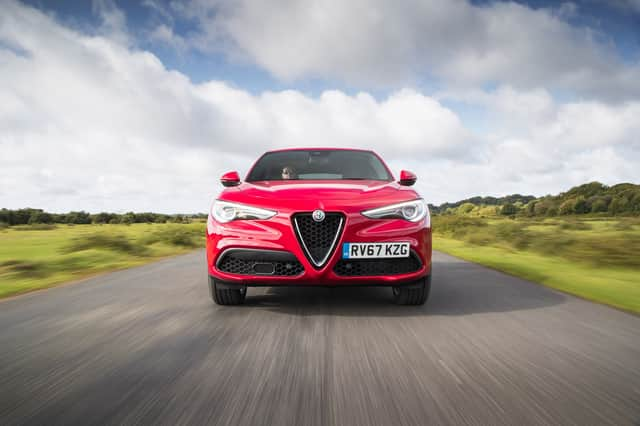MOTORS REVIEW: Alfa Romeo Stelvio


The British-built F-Pace has taken the market somewhat by storm since its launch last summer and it’s fair to say that — while the effortlessly graceful, Turin-born Stelvio is every bit a direct rival — anticipated sales of around 4,000 cars-a-year mean that it’s little threat.
Nonetheless, on the back of an impressive week at the wheel of the 500bhp-plus Giulia Quadrifoglio saloon, expectations were high as I headed to Northern Ireland to sample the Stelvio.
Advertisement
Hide AdAdvertisement
Hide AdLike its saloon sibling, the Stelvio has already hit headlines in performance-focused Quadrifoglio guise, the 503bhp twin-turbocharged 2.9- litreV6 due in showrooms next year setting the fastest ever lap by an SUV at the Nurburgring (7 minutes 51.7 seconds).
For now, the range features 176bhp and 207bhp 2.2-litre turbodiesels and 197bhp and 276bhp two-litre turbocharged petrol engines all fitted with an eight-speed automatic gearbox.
Rear-wheel-drive — branded as Q2 — is available on the standard Stelvio and ‘Super’ specifications, in conjunction with the lower-powered diesel model, with the Q4-badged all-wheel-drive system standard on all Speciale and Milano Edizione trim levels.
Prices range from £33,990 to £45,390.
The line-up of idling Stelvios at Belfast’s George Best Airport added a little colour to an otherwise grey scene, rain dripping down smooth, fuss-free panels.
Advertisement
Hide AdAdvertisement
Hide AdUp front, the upright Alfa Romeo grille is larger than ever, a long bonnet and muscular haunches alluding to the SUV’s rear-driven bias.
Three standard trim levels are available from launch.
The entry-level Stelvio includes 17-inch alloys, LED rear lights, twin chrome exhausts outside and dual-zone climate control, a 3.5-inch TFT colour cluster instrument panel, a UConnect 8.8-inch infotainment system with DAB radio and Bluetooth connectivity in the cabin.
Super trim adds 18-inch alloys and front parking sensors, a 3D sat-nav system, a seven-inch TFT instrument cluster and two-tone leather dashboard and leather and cloth upholstery.
Speciale features 19-inch alloys with red brake calipers, Bi-Xenon headlights, heated leather seats and Ferrari-esque aluminium shift paddles on the steering column, while the range-topping Milano Edizione delivers uprated leather trim and sound system, 20-inch alloys and keyless entry among its premium perks.
Advertisement
Hide AdAdvertisement
Hide AdA range-wide five-star rating in Euro NCAP’s safety tests, meanwhile, came as a result of inclusion of what is billed as a “segment-first” brakeby- wire braking system as standard (this is said to deliver ABS without the usual fluctuation in pedal feel) as well as autonomous emergency braking with pedestrian detection, blind spot monitoring, collision warning and lane departure warning systems.
Alfa Romeo has gone to great lengths to deliver something special in developing the new Giorgio platform which underpins the Stelvio and Guilia.
A carbonfibre drive shaft is something that might be expected of the FCA Group’s Ferrari brand, while aluminium doors, bonnet, boot, suspension and sub-frames all contribute to a claimed kerb weight of 1,659kg — usefully lighter that the 1,775kg equivalent F-Pace.
The result is impressive performance. At its most potent the Stelvio will reach 62mph in 5.7 seconds and a top speed of 143mph, the entry level 180PS diesel managing the same acceleration benchmark in 7.6 seconds.
Advertisement
Hide AdAdvertisement
Hide AdThe entry-level model is the most frugal, claiming 60.1mpg and 124g/km CO2 emissions which make it cleaner than the F-Pace and Mercedes-Benz GLC but not the new Volvo XC 60 which is said to deliver 62.8mpg in diesel guise and an unlikely 134mpg as a plug-in hybrid.
Dynamically, though, the Stelvio feels comparable to the F-Pace.
Fundamentally rear-wheel-drive, 100 per cent of power is sent to the rear wheels until the detection of a loss of traction can see as much as 50 per cent delivered to the front.
The Stelvio exhibits a similarly quick-witted and direct helm to that of the Giulia saloon, too.
Advertisement
Hide AdAdvertisement
Hide AdIt could feel a little over-alert for those expecting the usual reactions of a car that places the driver at this height from the road, but there is polish in that new platform, the suspension striking a delicate balance between pliancy and control.
Only over undulating roads does the ride eventually feel a little under-damped. Generally, it is poised and accurate.
An over-abrupt initial braking phase and limited feel through a left pedal which has no mechanical link to the callipers might prove an acquired taste, however.
The Stelvio’s interior is less of an acquired taste.
The same neatly integrated touchscreen and aforementioned sculptural paddle shifters as the Giulia are among the highlights.
Advertisement
Hide AdAdvertisement
Hide AdRough-grained woods form part of the dashboard inlay while a handsome three-spoke steering wheel makes a fine contact point.
A stylish, clutter-free feel reflects the effortless feel of the exterior’s appeal.
That said, the UConnect infotainment system is well off the pace of Audi, Mercedes-Benz and Jaguar Land Rover equivalents in terms of graphics and general intuitive usability.
Where the Stelvio delivers with ease is in emotional appeal, where Alfa Romeo would expect it to.
Advertisement
Hide AdAdvertisement
Hide AdIn the metal, it is not as immediately striking as an F-Pace, but has real polish and grace along with a degree of exclusivity on its side.
From behind the wheel, it feels enough like the impressive Giulia to appeal on a dynamic level too.
Two impressive Alfa Romeos within the space of a month? It feels like the brand is finally making a concerted effort to move in the right direction.
First published October 20th